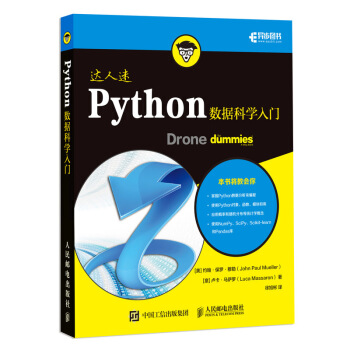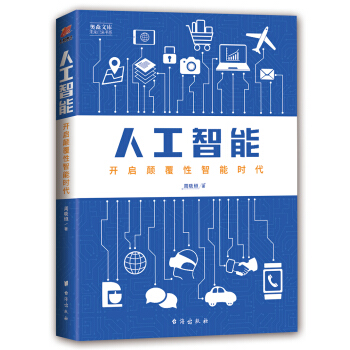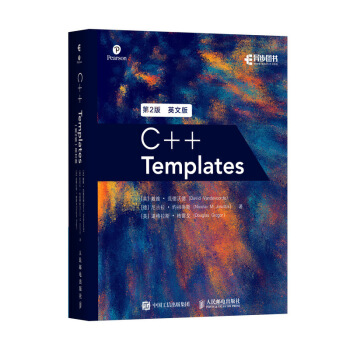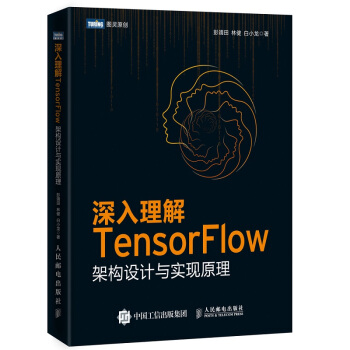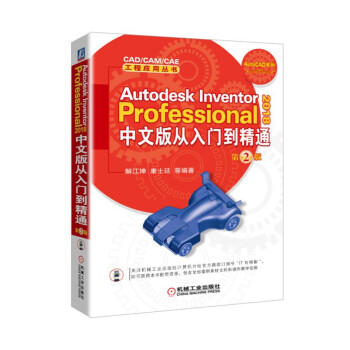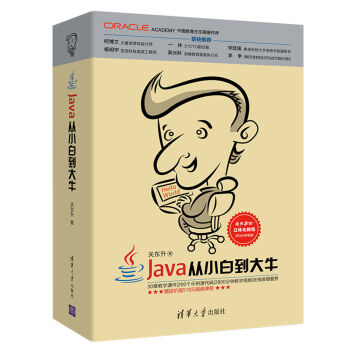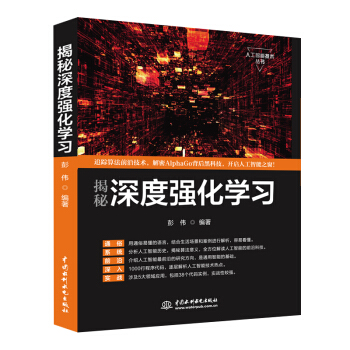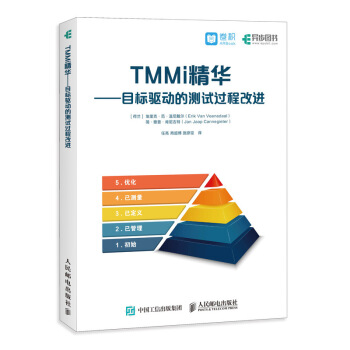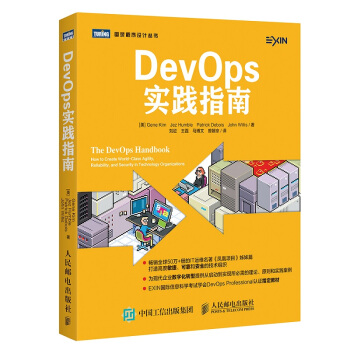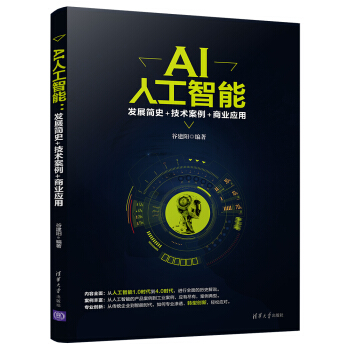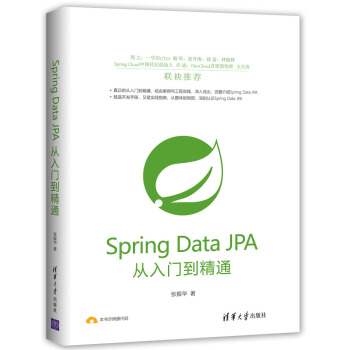具体描述
编辑推荐
适读人群 :CAE工程师;工科院校师生
1. 作者:CAE应用联盟专家编写,畅销书改版。
2. 内容全面:15个综合工程案例带你迅速掌握ABAQUS核心功能。 内容简介
《ABAQUS 2016有限元分析从入门到精通 第2版》以ABAQUS 2016版为软件平台,介绍了ABAQUS的操作命令及其在工程结构数值分析中的使用方法和技巧。
《ABAQUS 2016有限元分析从入门到精通 第2版》分基础应用篇和实际工程篇两个层次讲解,共17章。基础应用篇(第1~9章)包括有限单元法的基础理论、ABAQUS入门知识介绍、几何建模技术与技巧、分析步的概念与设置方法、相互作用的概念与使用、载荷与边界条件的定义、网格的划分、作业的创建与设置以及可视化后处理技术;实际工程篇(第10~17章)依托工程中常见的实例,按照不同的分析方式,分层次、分类别地进行了详尽的操作演示与方法教学。本书根据实际应用为读者提供的专题包括结构静力学分析、显式与隐式的动力学分析、线性与非线性的静力与动力学分析、接触分析、热结构耦合问题分析、多体系统分析、加工过程仿真等,具有一定的参考价值。
《ABAQUS 2016有限元分析从入门到精通 第2版》工程背景深厚、内容丰富、讲解详尽,内容安排由浅入深,适用于不同层次的ABAQUS用户,既可作为大、中专院校相关专业高年级本科生、研究生的参考用书,也可供相关专业的工程技术人员参考使用。 目录
基础应用篇
第1章 有限单元法分析概述
1.1 有限单元法基础理论
1.2 ABAQUS简介
1.3 ABAQUS文件系统
1.4 ABAQUS 使用环境
1.5 本章小结
第2章 ABAQUS操作入门
2.1 ABAQUS用户界面
2.2 ABAQUS相关约定
2.2.1 ABAQUS中的单位制
2.2.2 ABAQUS中的坐标系
2.2.3 ABAQUS中的自由度
2.3 ABAQUS分析流程
2.4 本章小结
第3章 建立模型
3.1 部件与草图(Part & Sketch)
3.1.1 部件模块简介
3.1.2 建模实例—灭火器启动开关
3.1.3 建模实例—书架结构
3.2 属性(Property)
3.2.1 属性模块简介
3.2.2 创建材料
3.2.3 创建与指派截面
3.3 装配(Assembly)
3.3.1 书架零件装配
3.3.2 导入部件
3.4 本章小结
第4章 分析步
4.1 分析步
4.1.1 准备模型
4.1.2 通用静力学分析步
4.1.3 通用隐式动力学分析步
4.1.4 通用显式动力学分析步
4.1.5 线性摄动分析步
4.2 输出设置
4.2.1 输出请求管理器
4.2.2 编辑输出请求
4.3 分析步模块的其他功能
4.3.1 ALE自适应网格
4.3.2 求解控制
4.4 本章小结
第5章 相互作用
5.1 相互作用
5.1.1 接触属性
5.1.2 定义接触
5.2 约束(Constraint)
5.2.1 绑定(Tie)约束
5.2.2 刚体(Rigid body)约束
5.2.3 显示体(Display body)约束
5.2.4 耦合(Coupling)约束
5.3 连接器(Connector)
5.3.1 连接器的截面特性
5.3.2 连接器的特征线
5.3.3 连接单元
5.4 接触面的过盈量
5.4.1 ADJUST参数定义
5.4.2 *CONTACT INTERFERENCE
5.4.3 *CLEARANCE
5.5 接触分析中的收敛问题
5.5.1 检查接触关系、边界条件和约束
5.5.2 消除刚体位移
5.5.3 使用绑定约束
5.5.4 建立平稳的接触关系
5.5.5 细化网格
5.5.6 正确地定义主面和从面
5.5.7 使用一阶单元
5.5.8 避免过约束
5.5.9 慎重地定义摩擦
5.5.10 减小初始时间增量步
5.5.11 解决震颤问题
5.6 本章小结
第6章 载荷与边界条件
6.1 载荷(Load)
6.1.1 定义载荷
6.1.2 集中力
6.1.3 弯矩
6.1.4 压强
6.2 边界条件(Boundary Condition)
6.2.1 创建边界条件
6.2.2 编辑对称/反对称/完全固定边界条件
6.2.3 编辑位移/旋转边界条件
6.3 本章小结
第7章 网格划分
7.1 种子(SEED)
7.1.1 为部件实例布种
7.1.2 为边布种
7.2 网格控制
7.2.1 网格形状
7.2.2 网格划分技术与算法
7.2.3 网格控制注意事项
7.3 单元族
7.3.1 单元的表征
7.3.2 实体单元
7.3.3 壳单元
7.3.4 梁单元
7.3.5 桁架单元
7.4 网格划分
7.4.1 选择单元类型
7.4.2 划分网格
7.5 网格划分进阶技巧
7.5.1 网络检查
7.5.2 高质量的网格
7.6 本章小结
第8章 作业
8.1 作业模块
8.1.1 各功能模块调用逻辑
8.1.2 创建作业
8.1.3 管理作业
8.2 网格自适应过程
8.3 本章小结
第9章 后处理与数据可视化
9.1 在模型上显示结果
9.1.1 变形图
9.1.2 云图
9.1.3 符号变量
9.2 图表输出
9.2.1 历程变量XY数据输出
9.2.2 场变量XY数据输出
9.2.3 关于路径的XY变量输出
9.3 制作动画
9.4 本章小结
实际工程篇
第10章 线性静力分析
10.1 线性静力学分析概述
10.1.1 静力学分析的基本概念
10.1.2 结构静力学分析的方法
10.2 线性静力学分析—轴承座
10.2.1 问题描述
10.2.2 分析过程
10.3 五个基本假设
10.4 初识INP文件
10.4.1 INP文件概述
10.4.2 INP文件实例讲解
10.5 本章小结
第11章 非线性分析
11.1 非线性问题概述
11.1.1 线性与非线性
11.1.2 非线性的来源
11.1.3 非线性问题求解方法
11.2 非线性问题实例
11.2.1 几何非线性问题——薄板的大变形
11.2.2 材料非线性问题——橡胶的超弹性
11.3 本章小结
第12章 动力学分析
12.1 动力学分析的理论基础
12.1.1 固有频率和模态
12.1.2 振型叠加
12.1.3 阻尼
12.1.4 瞬态动力学
12.2 动力学问题实例
12.2.1 线性动力学问题实例——模态分析
12.2.2 非线性动力学问题实例——冲击与侵彻
12.3 结构谐响应分析详解
12.3.1 谐响应分析概述
12.3.2 谐响应分析流程
12.3.3 双-质量-弹簧系统的谐响应分析
12.4 本章小结
第13章 接触问题分析
13.1 接触问题概述
13.1.1 接触面间的相互作用
13.1.2 在ABAQUS中定义接触
13.1.3 接触算法
13.1.4 接触工程分析的关键技术
13.2 接触问题实例
13.2.1 接触问题基础实例——法兰的密封尺寸
13.2.2 刚性接触问题实例——塑性加工过程仿真
13.3 本章小结
第14章 显式动态分析
14.1 显式动态分析简介
14.1.1 显式动态问题的产生及其形式
14.1.2 显式动态分析的主要方法
14.1.3 隐式和显式的比较
14.2 显式动态分析实例
14.2.1 ABAQUS/Explicit实例——手机跌落测试
14.2.2 ABAQUS/Explicit实例——弹丸侵蚀靶体的分析
14.3 本章小结
第15章 热分析
15.1 热力学基础知识
15.1.1 符号与单位
15.1.2 热分析相关基础知识
15.2 热分析实例
15.2.1 ABAQUS瞬态热分析——金属散热管的温度场研究
15.2.2 ABAQUS热应力分析——刹车盘片的热效应
15.3 本章小结
第16章 多体系统分析
16.1 ABAQUS多体系统分析
16.1.1 ABAQUS进行多体系统分析模拟步骤
16.1.2 ABAQUS/CAE进行多体系统分析需要注意的问题
16.2 ABAQUS连接单元和连接属性
16.2.1 ABAQUS中使用连接单元的步骤
16.2.2 连接单元边界条件和载荷
16.2.3 连接单元行为
16.2.4 ABAQUS的连接属性
16.3 多体系统分析实例——风力发电机叶片旋转过程模拟
16.4 多体分析要注意的问题
16.4.1 多体分析中的过约束
16.4.2 选择连接属性和边界条件
16.5 本章小结
第17章 加工仿真应用
17.1 机械加工仿真概述
17.1.1 机械加工问题的特征
17.1.2 计算成本优化
17.2 机械加工仿真实例
17.2.1 ABAQUS仿真实例——旋压加工
17.2.2 ABAQUS仿真实例——铆接
17.3 本章小结 前言/序言
ABAQUS融结构、热力学、流体、电磁、声学和爆破分析于一体,具有强大的前后处理及计算分析能力,能够同时模拟结构、热、流体、电磁以及多种物理场间的耦合效应。
《ABAQUS 2016有限元分析从入门到精通 第2版》以ABAQUS 2016版为软件平台,依托大量的工程实例,具体讲解运用ABAQUS高级有限元分析软件处理工程问题的方法与详细步骤。本书的目的是使读者系统地掌握BAQUS的使用方法,能够对各种工程结构进行规划、建模、加载求解与结果处理,并编写相应的INP文件(输入文件)。
1.本书特点
● 由浅入深:本书以初、中级读者为对象,首先从ABAQUS使用基础讲起,再辅以ABAQUS在工程中的应用案例帮助读者尽快掌握使用ABAQUS进行有限元分析的技能。
● 步骤详尽:本书结合作者多年ABAQUS使用经验与实际工程应用案例,将ABAQUS软件的使用方法与技巧详细地讲解给读者。本书在讲解过程中步骤详尽,讲解过程辅以相应的图片,使读者在阅读时一目了然,从而快速掌握书中所讲内容。
● 实例典型:学习实际工程应用案例的具体操作是掌握ABAQUS的最好方式。本书通过综合应用案例,透彻详尽地讲解了ABAQUS在各领域应用的方法和技巧。
2.本书内容
《ABAQUS 2016有限元分析从入门到精通 第2版》分基础应用篇和实际工程篇两个层次。
● 基础应用篇(第1~9章)包括有限单元法的基础理论、ABAQUS入门知识、几何建模技术与技巧、分析步的概念与设置方法、相互作用的概念与使用、载荷与边界条件的定义、网格的划分、作业的创建与设置以及可视化后处理技术。章节设置如下。
第1章有限单元法分析概述 第2章ABAQUS操作入门
第3章建立模型 第4章分析步
第5章相互作用 第6章载荷与边界条件
第7章网格划分 第8章作业
第9章后处理与数据可视化
● 实际工程篇(第10~17章)依托工程中常见的实例,按照不同的分析方式,分层次、分类别地进行了详尽的操作演示与方法教学。书中选取相关领域内的最具代表性工程问题为实例进行建模及加载求解,并以工程中的常用技术控制指标为依据进行后处理分析。章节设置如下。
第10章线性静力分析 第11章非线性分析
第12章动力学分析 第13章接触问题分析
第14章显式动态分析 第15章热分析
第16章多体系统分析 第17章加工仿真应用
《ABAQUS 2016有限元分析从入门到精通 第2版》专题实例中的每个例子都包含了图形界面操作和INP文件(输入文件)两种方式,两种方式在效果上完全等价。其中,图形界面方式通俗易懂且分析步骤一目了然;INP文件(输入文件)方式方便快捷,适合复杂问题的分析,而且可以控制在图形界面中无法进行的高级操作。读者应同时掌握两种分析方式,根据不同的具体问题,采用相对方便的方式。
提示:《ABAQUS 2016有限元分析从入门到精通 第2版》附赠网盘资源中包含书中所有案例用到的素材源文件以及INP文件,以方便读者学习使用。
3.读者对象
《ABAQUS 2016有限元分析从入门到精通 第2版》既适合于ABAQUS的初、中级读者学习使用,也可供工程技术人员参考使用,具体读者对象如下。
● 大中专院校的教师和在校生 ● 初学ABAQUS的技术人员
● 参加工作实习的“菜鸟” ● 相关培训机构的教师和学员
● 广大科研工作人员 ● ABAQUS爱好者
● 初、中级ABAQUS从业人员
4.读者服务
为了方便解决《ABAQUS 2016有限元分析从入门到精通 第2版》疑难问题,读者朋友在学习过程中遇到与本书有关的技术问题,可以发邮件到邮箱caxart@126.com,或者访问博客http://blog.sina.com.cn/caxart,作者会尽快给予解答。
5.本书作者
《ABAQUS 2016有限元分析从入门到精通 第2版》主要由张建伟编著,另外,参与编写的还有丁金滨、石良臣、林金宝、张亮亮、高飞、李昕、唐宗鹏、凌桂龙、王芳、张岩、韩希强、孙国强、于苍海、温正、陈艳霞、郭海霞、刘成柱、宋玉旺、沈再阳、陈峰浩、张文电、丁凯、王菁和李战芬。
虽然作者在《ABAQUS 2016有限元分析从入门到精通 第2版》的编写过程中力求叙述准确、完善,但由于水平有限,书中欠妥之处在所难免,希望读者和同仁能够及时指出,共同促进《ABAQUS 2016有限元分析从入门到精通 第2版》质量的提高。最后再次希望《ABAQUS 2016有限元分析从入门到精通 第2版》能为读者的学习和工作提供帮助!
finite element analysis in 3d design and simulation with ABAQUS 2016, Second Edition This comprehensive guide delves into the intricate world of Finite Element Analysis (FEA) as applied through the powerful ABAQUS 2016 software. Designed for both newcomers eager to grasp the fundamentals and seasoned engineers aiming to elevate their proficiency, this volume offers a structured and progressive learning path. It moves beyond basic theory, immersing the reader in practical applications and advanced techniques essential for tackling complex engineering challenges. The focus remains squarely on the application of FEA principles within the ABAQUS environment, equipping individuals with the skills to translate theoretical knowledge into tangible, accurate simulations. A Deep Dive into FEA Fundamentals and ABAQUS Implementation The journey begins with a thorough exploration of the core concepts underpinning Finite Element Analysis. Readers will gain a solid understanding of what FEA is, its fundamental principles, and why it has become an indispensable tool in modern engineering design and research. This foundational knowledge is then meticulously mapped onto the ABAQUS 2016 software. The text meticulously details the software's architecture, user interface, and the critical modules that facilitate the FEA process. Expect to learn how to effectively navigate the software, understand its various solvers, and appreciate the underlying mathematical formulations that drive its analytical capabilities. Key theoretical underpinnings are explained with clarity and precision. This includes discussions on: Discretization: The process of dividing a complex continuous structure into a finite number of simpler elements (mesh generation). The book will explore various meshing strategies, element types (e.g., continua, shells, beams), and the implications of mesh density and quality on simulation accuracy. Techniques for generating high-quality meshes, including automatic and manual meshing, refinement, and quality assessment, will be thoroughly covered. Element Formulations: Understanding the mathematical basis of different element types, their strengths, limitations, and suitability for various problem domains. This section will touch upon isoparametric elements, shape functions, and stiffness matrices, providing insights into how ABAQUS represents and solves the governing equations for each element. Stiffness Matrix Assembly: The crucial step of combining individual element stiffness matrices into a global stiffness matrix representing the entire structure. Readers will learn how loads and boundary conditions are incorporated into this process. Solution of Equations: The methods employed by ABAQUS to solve the resulting system of linear or non-linear equations, including direct and iterative solvers. The advantages and disadvantages of different solver types for various problem scenarios will be discussed. Post-processing: Interpreting the results of FEA simulations, including stress, strain, displacement, and other relevant quantities. The book will guide readers through effectively visualizing and analyzing simulation outputs to extract meaningful engineering insights. Mastering the ABAQUS Workflow: From Pre-processing to Post-processing The practical application of FEA in ABAQUS 2016 is the cornerstone of this volume. A significant portion is dedicated to guiding the reader through the complete simulation workflow, breaking down each stage into manageable and understandable steps. Pre-processing: Laying the Groundwork for Accurate Simulations This section is a deep dive into preparing your model for analysis. It covers: Geometry Creation and Import: Techniques for creating complex geometries directly within ABAQUS, as well as importing geometries from popular CAD software (e.g., SolidWorks, CATIA, AutoCAD). Emphasis will be placed on ensuring geometry integrity and suitability for meshing. The importance of defeaturization and simplification of CAD models will be highlighted. Material Definition: A comprehensive look at defining material properties. This includes linear elastic materials, plasticity models (e.g., von Mises, Drucker-Prager), hyperelastic materials, viscoelastic materials, and other advanced material behaviors. Readers will learn how to select appropriate material models based on the expected material response and how to input material parameters accurately. Section Properties: Defining the cross-sectional characteristics of structural components, such as beam cross-sections, shell thickness, and solid element properties. This is crucial for accurately representing the physical behavior of the structure. Meshing Strategies: As mentioned earlier, this is a critical aspect. The book will cover techniques for generating appropriate meshes for different element types and geometric complexities. It will address issues like element distortion, mesh convergence, and the impact of mesh refinement on accuracy and computational cost. Different meshing algorithms available in ABAQUS will be explored. Boundary Conditions and Loads: Applying realistic constraints and external forces to the model. This includes fixed supports, roller supports, prescribed displacements, concentrated loads, distributed loads, pressure loads, and thermal loads. The accurate application of boundary conditions is paramount for obtaining meaningful results. Analysis Setup: Configuring Your Simulation This stage involves defining the analysis type and its parameters: Step Definition: Understanding different analysis types such as static, dynamic, buckling, thermal, and coupled analyses. The book will guide readers in selecting the appropriate analysis step for their specific problem. Time Period and Increment Control: For dynamic or non-linear analyses, controlling the time duration and the size of time increments is crucial for stability and accuracy. Techniques for managing these parameters will be explained. Solver Selection: Choosing the appropriate solver (e.g., direct sparse solver, iterative solvers) based on the problem size, stiffness, and computational resources. Output Requests: Specifying the quantities to be extracted and saved during the simulation, such as displacements, stresses, strains, reaction forces, and energy values. Post-processing: Unveiling the Simulation Insights This is where the raw simulation data is transformed into actionable engineering knowledge: Visualization Techniques: Effectively visualizing simulation results using ABAQUS's powerful visualization tools. This includes contour plots, vector plots, deformed shape plots, and animations. Data Extraction and Interpretation: Extracting specific data points, creating XY plots, and understanding the meaning of various stress and strain measures. The book will provide guidance on how to interpret these results in the context of engineering design criteria and failure modes. Convergence Studies: Performing mesh convergence and load convergence studies to ensure that the simulation results are independent of the mesh density and time increments. This is a critical step in validating simulation accuracy. Validation and Verification: Comparing simulation results with experimental data or analytical solutions to verify the accuracy and reliability of the FEA model. Advanced Topics for the Discerning Engineer Beyond the core workflow, this volume ventures into more sophisticated FEA applications and ABAQUS functionalities: Non-linear Analysis: A significant focus will be placed on non-linear analyses, which are essential for simulating real-world engineering problems where material behavior, large deformations, or contact phenomena are significant. This includes: Material Non-linearity: Simulating plastic deformation, creep, and other inelastic material behaviors. Geometric Non-linearity: Analyzing structures undergoing large displacements and rotations where the stiffness matrix changes significantly. Contact Analysis: Modeling the interaction between different parts of a structure, including surface-to-surface contact, edge-to-surface contact, and the effects of friction. Techniques for defining contact properties, enforcing contact constraints, and ensuring stable contact solutions will be detailed. Dynamic Analysis: Simulating the response of structures to time-varying loads, including modal analysis, transient dynamic analysis, and response spectrum analysis. Applications such as vibration analysis, impact simulation, and seismic analysis will be explored. Buckling Analysis: Investigating the stability of structures under compressive loads and predicting critical buckling loads. Thermal-Structural Coupling: Analyzing problems where thermal loads induce mechanical stresses and deformations, or where mechanical loading affects temperature distribution. Fatigue Analysis: Understanding the principles of fatigue and how to perform fatigue simulations to predict the lifespan of components under cyclic loading. Submodeling Techniques: Employing submodeling to achieve high-fidelity results in critical areas of a large model without needing to mesh the entire structure with excessive refinement. User Subroutines (VUMAT, UMAT, etc.): For advanced users, the book will introduce the concept of user subroutines, allowing for the implementation of custom material models, element formulations, or other user-defined behaviors. Practical Case Studies and Real-World Applications To solidify understanding and demonstrate the practical utility of FEA with ABAQUS, the book is replete with carefully selected case studies and real-world examples. These examples span various engineering disciplines, showcasing how ABAQUS is used to solve problems in: Structural Engineering: Analysis of bridges, buildings, aerospace components, and automotive structures. Mechanical Engineering: Design and analysis of machine components, pressure vessels, and thermal systems. Materials Science: Simulating material behavior under various conditions, including fracture and failure. Biomechanics: Analysis of biological tissues and implants. Each case study will be presented in a step-by-step manner, guiding the reader through the entire FEA process from problem definition to result interpretation. The challenges encountered and the solutions implemented will be thoroughly explained, offering valuable practical insights. Target Audience and Learning Objectives This book is an invaluable resource for: Undergraduate and Graduate Students: Seeking to gain a practical understanding of FEA and its application in their coursework and research projects. Design Engineers and Analysts: Aiming to enhance their skills in using ABAQUS for product design, optimization, and failure analysis. Researchers and Academics: Exploring advanced FEA techniques and their application in cutting-edge research. Anyone interested in mastering the art and science of numerical simulation for engineering problems. Upon completing this volume, readers will be equipped to: Understand the fundamental principles of Finite Element Analysis. Effectively utilize ABAQUS 2016 software for a wide range of engineering simulations. Prepare complex models for analysis, including geometry, material, and boundary conditions. Set up and execute various types of FEA analyses, including static, dynamic, and non-linear simulations. Interpret and validate simulation results to make informed design decisions. Apply advanced FEA techniques to solve challenging engineering problems. By bridging theoretical knowledge with practical application, this book serves as a definitive guide to mastering finite element analysis with ABAQUS 2016, empowering individuals to confidently tackle sophisticated engineering challenges and drive innovation.





